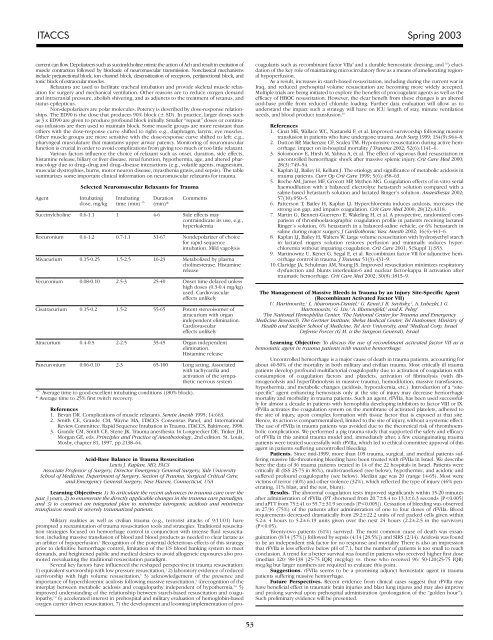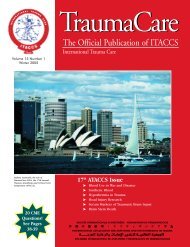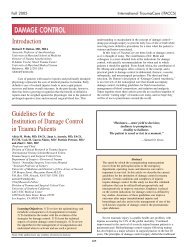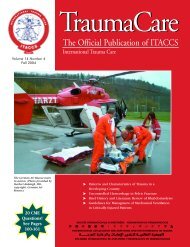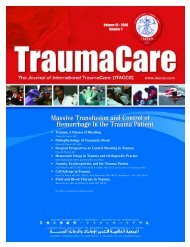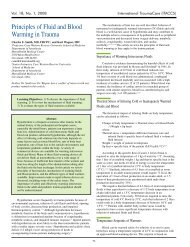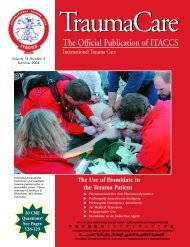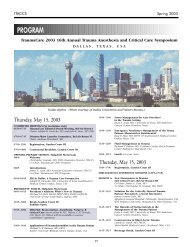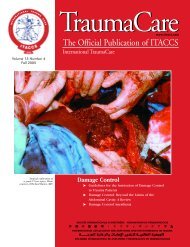The Official Publication of ITACCS - International Trauma ...
The Official Publication of ITACCS - International Trauma ...
The Official Publication of ITACCS - International Trauma ...
You also want an ePaper? Increase the reach of your titles
YUMPU automatically turns print PDFs into web optimized ePapers that Google loves.
<strong>ITACCS</strong> Spring 2003<br />
current can flow. Depolarizers such as succinylcholine mimic the action <strong>of</strong> Ach and result in excitation <strong>of</strong><br />
muscle contraction followed by blockade <strong>of</strong> neuromuscular transmission. Nonclassical mechanisms<br />
include prejunctional block, ion channel block, desensitization <strong>of</strong> receptors, perijunctional block, and<br />
tonic block <strong>of</strong> extraocular muscles.<br />
Relaxants are used to facilitate tracheal intubation and provide skeletal muscle relaxation<br />
for surgery and mechanical ventilation. Other reasons are to reduce oxygen demand<br />
and intracranial pressure, abolish shivering, and as adjuncts to the treatment <strong>of</strong> tetanus, and<br />
status epilepticus.<br />
Non-depolarizers are polar molecules. Potency is described by dose-response relationships.<br />
<strong>The</strong> ED90 is the dose that produces 90% block (± SD). In practice, larger doses such<br />
as 3 x ED90 are given to produce pr<strong>of</strong>ound block initially. Smaller “repeat” doses or continuous<br />
infusions are then used to maintain block. Some muscle groups are more resistant than<br />
others with the dose-response curve shifted to right: e.g., diaphragm, larynx, eye muscles.<br />
Other muscle groups are more sensitive with the dose-response curve shifted to left: e.g.,<br />
pharyngeal musculature that maintains upper airway patency. Monitoring <strong>of</strong> neuromuscular<br />
function is crucial in order to avoid complications from giving too much or too little relaxant.<br />
Various factors influence the choice <strong>of</strong> relaxant such as onset, duration, side effects,<br />
histamine release, biliary or liver disease, renal function, hypothermia, age, and altered pharmacology<br />
due to drug–drug and drug–disease interactions (e.g., volatile agents, magnesium,<br />
muscular dystrophies, burns, motor neuron disease, myasthenia gravis, and sepsis). <strong>The</strong> table<br />
summarizes some important clinical information on neuromuscular relaxants for trauma.<br />
Selected Neuromuscular Relaxants for <strong>Trauma</strong><br />
Agent Intubating Intubating Duration Comments<br />
dose, mg/kg time (min)^ (min)*<br />
Succinylcholine 0.6-1.1 1 4-6 Side effects may<br />
contraindicate its use, e.g.,<br />
hyperkalemia<br />
Rocuronium 0.6-1.2 0.7-1.1 31-67 Nondepolarizer <strong>of</strong> choice<br />
for rapid sequence<br />
intubation. Mild vagolysis<br />
Mivacurium 0.15-0.25 1.5-2.5 16-23 Metabolized by plasma<br />
cholinesterase. Histamine<br />
release<br />
Vecuronium 0.08-0.10 2.5-3 25-40 Onset time delayed unless<br />
high doses (0.3-0.4 mg/kg)<br />
used. Cardiovascular<br />
effects unlikely<br />
Cisatracurium 0.15-0.2 1.5-2 55-65 Potent stereoisomer <strong>of</strong><br />
atracurium with organ<br />
independent elimination.<br />
Cardiovascular<br />
effects unlikely<br />
Atracurium 0.4-0.5 2-2.5 35-45 Organ independent<br />
elimination.<br />
Histamine release<br />
Pancuronium 0.06-0.10 2-3 65-100 Long acting. Associated<br />
with tachycardia and<br />
activation <strong>of</strong> the sympathetic<br />
nervous system<br />
^ Average time to good-excellent intubating conditions ((80% block).<br />
* Average time to 25% first twitch recovery.<br />
References<br />
1. Bevan DR. Complications <strong>of</strong> muscle relaxants. Semin Anesth 1995; 14:663.<br />
2. Smith CE, Grande CM, Wayne MA, <strong>ITACCS</strong> Consensus Panel, and <strong>International</strong><br />
Review Committee. Rapid Sequence Intubation in <strong>Trauma</strong>. <strong>ITACCS</strong>, Baltimore, 1998.<br />
3. Grande CM, Smith CE, Stene JK. <strong>Trauma</strong> anesthesia. In Longnecker DE, Tinker JH,<br />
Morgan GE, eds. Principles and Practice <strong>of</strong> Anesthesiology, 2nd edition. St. Louis,<br />
Mosby, chapter 81, 1997, pp 2138–64.<br />
Acid-Base Balance in <strong>Trauma</strong> Resuscitation<br />
Lewis J. Kaplan, MD, FACS<br />
Associate Pr<strong>of</strong>essor <strong>of</strong> Surgery, Director Emergency General Surgery, Yale University<br />
School <strong>of</strong> Medicine, Department <strong>of</strong> Surgery, Section <strong>of</strong> <strong>Trauma</strong>, Surgical Critical Care,<br />
and Emergency General Surgery, New Haven, Connecticut, USA<br />
Learning Objectives: 1) To articulate the recent advances in trauma care over the<br />
past 3 years, 2) to enumerate the directly applicable changes in the trauma care paradigm,<br />
and 3) to construct an integrated plan to minimize iatrogenic acidosis and minimize<br />
transfusion needs in severely traumatized patients.<br />
Military realities as well as civilian trauma (e.g., terrorist attacks <strong>of</strong> 9/11/01) have<br />
prompted a reexamination <strong>of</strong> trauma resuscitation tools and strategies. Traditional resuscitation<br />
strategies focused on hemorrhage control in conjunction with intense fluid resuscitation,<br />
including massive transfusion <strong>of</strong> blood and blood products as needed to clear lactate as<br />
an arbiter <strong>of</strong> hypoperfusion. 1 Recognition <strong>of</strong> the potential deleterious effects <strong>of</strong> this strategy<br />
prior to definitive hemorrhage control, limitation <strong>of</strong> the US blood banking system to meet<br />
demands, and heightened public and medical desires to avoid allogeneic exposures also promoted<br />
reevaluating the traditional resuscitation paradigm.<br />
Several key factors have influenced the reshaped perspective in trauma resuscitation:<br />
1) equivalent survivorship with low pressure resuscitation, 2 2) laboratory evidence <strong>of</strong> reduced<br />
survivorship with high volume resuscitation, 3 3) acknowledgement <strong>of</strong> the presence and<br />
importance <strong>of</strong> hyperchloremic acidosis following massive resuscitation, 4 4)recognition <strong>of</strong> the<br />
interplay between metabolic acidosis and coagulopathy independent <strong>of</strong> hypothermia, 5,6 5)<br />
improved understanding <strong>of</strong> the relationship between starch-based resuscitation and coagulopathy,<br />
7,8 6) accelerated interest in prehospital and military evaluation <strong>of</strong> hemoglobin-based<br />
oxygen carrier driven resuscitation, 7) the development and looming implementation <strong>of</strong> procoagulants<br />
such as recombinant factor VIIa 9 and a durable hemostatic dressing, and 10 ) elucidation<br />
<strong>of</strong> the key role <strong>of</strong> maintaining microcirculatory flow as a means <strong>of</strong> ameliorating regional<br />
hypoperfusion.<br />
As a result, increases in starch-based resuscitation, including during the current war in<br />
Iraq, and reduced prehospital volume resuscitation are becoming more widely accepted.<br />
Multiple trials are being initiated to explore the benefits <strong>of</strong> procoagulant agents as well as the<br />
efficacy <strong>of</strong> HBOC resuscitation. However, the clear benefit from these changes is an altered<br />
acid-base pr<strong>of</strong>ile from reduced chloride loading. Further data evaluation will allow us to<br />
understand the impact such a strategy will have on ICU length <strong>of</strong> stay, minute ventilation<br />
needs, and blood product transfusion. 10<br />
References<br />
1. Cinat ME, Wallace WC, Nastanski F, et al. Improved survivorship following massive<br />
transfusion in patients who have undergone trauma. Arch Surg 1999; 134(9):964–8.<br />
2. Dutton RP, Mackenzie CF, Scalea TM. Hypotensive resuscitation during active hemorrhage:<br />
impact on in-hospital mortality. J <strong>Trauma</strong> 2002; 52(6):1141–6.<br />
3. Solomonov E, Hirsh M, Yahiya A, et al. <strong>The</strong> effect <strong>of</strong> vigorous fluid resuscitation in<br />
uncontrolled hemorrhagic shock after massive splenic injury. Crit Care Med 2000;<br />
28(3):749–54.<br />
4. Kaplan LJ, Bailey H, Kellum J. <strong>The</strong> etiology and significance <strong>of</strong> metabolic acidosis in<br />
trauma patients. Curr Op Crit Care 1999; 5(6):458–63.<br />
5. Roche AM, James MF, Grocott MP, Mythen MG. Coagulation effects <strong>of</strong> in vitro serial<br />
haemodilution with a balanced electrolyte hetastarch solution compared with a<br />
saline-based hetastarch solution and lactated Ringer’s solution. Anaesthesia 2002;<br />
57(10):950–5.<br />
6. Patterson T, Bailey H, Kaplan LJ. Hyperchloremia induces acidosis, increases the<br />
strong ion gap, and impairs coagulation. Crit Care Med 2000; 28(12):A118.<br />
7. Martin G, Bennett-Guerrero E, Wakeling H, et al. A prospective, randomized comparison<br />
<strong>of</strong> thromboelastographic coagulation pr<strong>of</strong>ile in patients receiving lactated<br />
Ringer’s solution, 6% hetastarch in a balanced-saline vehicle, or 6% hetastarch in<br />
saline during major surgery. J Cardiothorac Vasc Anesth 2002; 16(4):441–6.<br />
8. Kaplan LJ, Bailey H, Walters W. Large volume resuscitation with hydroxyethyl starch<br />
in lactated ringers solution restores perfusion and minimally induces hyperchloremia<br />
without impairing coagulation. Crit Care 2001; 5(Suppl 1):S53.<br />
9. Martinowitz U, Kenet G, Segal E, et al. Recombinant factor VII for adjunctive hemorrhage<br />
control in trauma. J <strong>Trauma</strong> 51(3):431–9.<br />
10. Claridge JA, Schulman AM, Young JS. Improved resuscitation minimizes respiratory<br />
dysfunction and blunts interleukin-6 and nuclear factor-kappa B activation after<br />
traumatic hemorrhage. Crit Care Med 2002; 30(8):1815–9.<br />
<strong>The</strong> Management <strong>of</strong> Massive Bleeds in <strong>Trauma</strong> by an Injury Site-Specific Agent<br />
(Recombinant Activated Factor VII)<br />
U. Martinowitz, 1 L. Aharonson-Daniel, 2 G. Kenet,1 B. Savitsky, 2 , A. Lubezki,1 G.<br />
Martonowits, 3 G. Lin, 3 A. Blumenfeld, 3 and K. Peleg 2<br />
1<br />
<strong>The</strong> National Hemophilia Center, 2 <strong>The</strong> National Center for <strong>Trauma</strong> and Emergency<br />
Medicine Research, <strong>The</strong> Gertner Institute, Sheba Medical Center, Tel Hashomer, Ministry <strong>of</strong><br />
Health and Sackler School <strong>of</strong> Medicine, Tel Aviv University, and 3 Medical Corp, Israel<br />
Defense Forces (G.M. is the Surgeon General), Israel<br />
Learning Objective: To discuss the use <strong>of</strong> recombinant activated factor VII as a<br />
hemostatic agent in trauma patients with massive hemorrhage.<br />
Uncontrolled hemorrhage is a major cause <strong>of</strong> death in trauma patients, accounting for<br />
about 40-50% <strong>of</strong> the mortality in both military and civilian trauma. Most critically ill trauma<br />
patients develop pr<strong>of</strong>ound multifactorial coagulopathy due to activation <strong>of</strong> coagulation with<br />
consumption <strong>of</strong> coagulation factors and platelets, activation <strong>of</strong> fibrinolysis (with fibrinogenolysis<br />
and hyperfibrinolysis in massive trauma), hemodilution, massive transfusions,<br />
hypothermia, and metabolic changes (acidosis, hypocalcemia, etc.). Introduction <strong>of</strong> a “sitespecific”<br />
agent enhancing hemostasis only at the site <strong>of</strong> injury may decrease hemorrhagic<br />
mortality and morbidity in trauma patients. Such an agent, rFVIIa, has been used successfully<br />
for almost a decade in patients with hemophilia developing inhibitors to factor VIII or IX.<br />
rFVIIa activates the coagulation system on the membrane <strong>of</strong> activated platelets, adhered to<br />
the site <strong>of</strong> injury, upon complex formation with tissue factor that is exposed at that site.<br />
Hence, its action is compartmentalized, limited to the site <strong>of</strong> injury, without a systemic effect.<br />
<strong>The</strong> use <strong>of</strong> rFVIIa in trauma patients was avoided due to the theoretical risk <strong>of</strong> thromboembolic<br />
complications. We performed a pig trauma study that supported the safety and efficacy<br />
<strong>of</strong> rFVIIa in this animal trauma model and, immediately after, a few exsanguinating trauma<br />
patients were treated successfully with rFVIIa, which led to ethical committee approval <strong>of</strong> this<br />
agent in patients suffering uncontrolled bleeding.<br />
Patients. Since mid-1999, more than 105 trauma, surgical, and medical patients suffering<br />
massive life-threatening bleeding have been treated with rFVIIa in Israel. We describe<br />
here the data <strong>of</strong> 36 trauma patients treated in 14 <strong>of</strong> the 22 hospitals in Israel. Patients were<br />
critically ill (ISS 25-75 in 86%), multi-transfused (see below), hypothermic, and acidotic and<br />
suffered pr<strong>of</strong>ound coagulopathy (see below). Median age was 20 (range 14-65). Most were<br />
victims <strong>of</strong> terror (40%) and other violence (32%), which reflected the type <strong>of</strong> injury (46% penetrating,<br />
11% blast, and the rest, blunt).<br />
Results. <strong>The</strong> abnormal coagulation tests improved significantly within 15-20 minutes<br />
after administration <strong>of</strong> rFVIIa (PT shortened from 20.7±8.4 to 13.3±6.3 seconds [P


